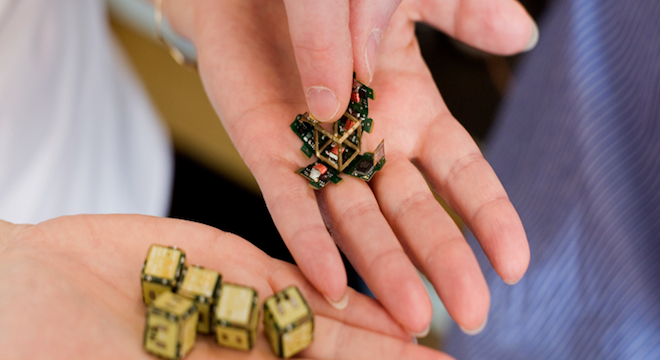It sounds like something out of a comic book: Grains of artificial “smart sand” that are capable of selectively, intelligently clumping together to replicate any other solid object. But the substance could soon be real, according to several researchers at MIT’s Computer Science and Artificial Intelligence Laboratory, who are working on creating it.
On Monday, MIT announced that researchers had successfully developed a prototype of the system out of robotic, magnetic cubes — “robot pebbles” — each one cubic centimeter, or 10 mm per side, that could successfully replicate 2D shapes. Shapes replicated so far include 2 x 2 cubes and 90-degree blocks.
The team has also developed algorithms that reliably simulate what the system would be like when scaled down to “sand-sized particles” and it has the potential to be revolutionary, allowing someone to stick a solid object in the smart sand and watch it self-sculpt itself into an exact copy within several minutes.
“For specific times, most of our hardware experiments with simple shapes took less than one minute,” said Kyle Gilpin, one of the MIT researchers who devised the technology, in an email to TPM.
MIT’s Daniela Rus, director of the Distributed Robotics Laboratory, first came up with the idea for the smart sand, Gilpin explained.
The system works like this: An object is buried in smart sand. Each grain of sand — or robotic pebble — that touches the outside of the object detects and maps the object’s shape.
When the entire shape has been mapped, the pebbles send a message to other grains that aren’t touching the object and instructs them to form a border identical to that of the object. Then, the pebbles inside the border automatically link together to solidfy and mirror the consistency of the original object placed inside the sand. The rest of the pebbles are sent a message to “disassociate,” or break apart, and only the duplicate shape and the original object remain as solid objects.
Gilpin outlines the process in the following video.
Gilpin and his collaborators will be presenting their incredible advances at a conference in May and have outlined them in several papers, one of which will be published later this year.
As for what types of devices Gilpin and his crew envision their smart sand being used to build, the MIT researcher provided a fascinating vision to TPM:
“The most obvious goal/use is rapid fabrication of tools and intelligent objects,” Gilpin said. “Say you’re at the South Pole for the winter when no flights can get in or out. A collection of our further miniaturized Robot Pebbles (aka Smart Sand) could be invaluable if you find yourself missing a specific size wrench or specialized part breaks.”
As Gilpin explained: “The Robot Pebbles can not only form shapes, but intelligent shapes.”
Because each module contains sensing, computation, and communication capabilities, the objects formed by the system are also imbued with this intelligence. For example, it would be very easy to produce a torque wrench from the Pebbles in a single manufacturing step because pebbles in the neck of the wrench could potentially sense the applied torque and transmit it to Pebbles the handle where it could be displayed to the user. Even better, to avoid over-torquing your bolt, the wrench could be designed to actively break into two easily reassembled pieces when the desired torque is reached.
The system also works with multiple objects, according to Gilpin.
Not surprisingly, MIT’s research into the smart sand is being funded by the US Army Research Office, among other government agencies.
Still, it will likely be several more years, if not decades, before the system can be shrunk to the size that Gilpin and company are targeting.






